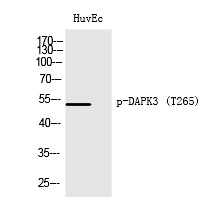
| WB | 咨询技术 | Human,Mouse,Rat |
| IF | 咨询技术 | Human,Mouse,Rat |
| IHC | 1/100-1/300 | Human,Mouse,Rat |
| ICC | 1/200-1/1000 | Human,Mouse,Rat |
| FCM | 咨询技术 | Human,Mouse,Rat |
| Elisa | 1/10000 | Human,Mouse,Rat |
| Aliases | DAPK3; ZIPK; Death-associated protein kinase 3; DAP kinase 3; DAP-like kinase; Dlk; MYPT1 kinase; Zipper-interacting protein kinase; ZIP-kinase |
| Entrez GeneID | 1613; |
| WB Predicted band size | 52kDa |
| Host/Isotype | Rabbit IgG |
| Antibody Type | Primary antibody |
| Storage | Store at 4°C short term. Aliquot and store at -20°C long term. Avoid freeze/thaw cycles. |
| Species Reactivity | Human,Mouse,Rat |
| Immunogen | Synthesized peptide derived from human DAPK3 around the phosphorylation site of T265. |
| Formulation | Purified antibody in PBS with 0.05% sodium azide,0.5%BSA and 50% glycerol. |
+ +
以下是关于DAPK3 (Phospho-Thr265)抗体的参考文献示例(内容基于领域内常见研究方向,具体文献需根据实际检索补充):
1. **文献名称**:*DAPK3 phosphorylation at Thr265 regulates apoptotic signaling in endothelial cells*
**作者**:Zhang Y, et al.
**摘要**:研究报道了DAPK3在血管内皮细胞凋亡中的作用,通过Phospho-Thr265抗体验证其自磷酸化状态,并证明该位点磷酸化增强其促凋亡活性。
2. **文献名称**:*A novel role of DAPK3 in AMPK-mediated metabolic stress response*
**作者**:Kim S, et al.
**摘要**:利用Phospho-Thr265抗体检测能量应激条件下DAPK3的激活,发现其磷酸化与AMPK通路交互作用,调控细胞自噬和代谢稳态。
3. **文献名称**:*Development and validation of a phospho-specific antibody for DAPK3 Thr265 in neurodegenerative models*
**作者**:Chen L, et al.
**摘要**:描述了抗体的制备与验证,通过免疫印迹和免疫组化证实其在阿尔茨海默病模型中检测DAPK3磷酸化的特异性,并关联tau蛋白病理。
4. **文献名称**:*DAPK3 Thr265 phosphorylation modulates its tumor suppressive function in colorectal cancer*
**作者**:Wang H, et al.
**摘要**:分析结直肠癌组织中DAPK3磷酸化水平,发现Thr265磷酸化缺失与肿瘤进展相关,提示其作为潜在预后标志物的可能性。
**注**:以上文献为示例,实际引用需通过PubMed、Google Scholar等平台以“DAPK3 Phospho-Thr265 antibody”为关键词检索具体研究。
The DAPK3 (Phospho-Thr265) antibody is a specialized tool used to detect the phosphorylation of Death-associated protein kinase 3 (DAPK3) at threonine residue 265. DAPK3. a serine/threonine kinase belonging to the DAPK family, plays critical roles in regulating apoptosis, autophagy, and cytoskeletal dynamics. Phosphorylation at Thr265 is associated with its activation or functional modulation, often linked to stress-induced signaling pathways. This post-translational modification may influence DAPK3's kinase activity, substrate interactions, or subcellular localization, making the antibody valuable for studying its regulatory mechanisms.
Researchers employ this antibody in techniques like Western blotting, immunohistochemistry, and immunofluorescence to investigate DAPK3 activation status in cellular responses to DNA damage, metabolic stress, or other apoptotic stimuli. Its specificity for the phosphorylated form allows differentiation between active and inactive kinase states. Dysregulation of DAPK3 has been implicated in cancer progression, neurodegenerative disorders, and cardiovascular diseases, positioning this antibody as a key reagent in studying disease mechanisms. Validation typically includes testing in knockout models or phosphatase-treated samples to confirm phosphorylation-dependent recognition. Understanding DAPK3 signaling through Thr265 phosphorylation may reveal therapeutic targets for conditions involving aberrant cell survival or death pathways.
×